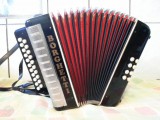Este post também está disponível em:
Português
English

The accordion, also popularly called accordion and harmonica, is an aerophone musical instrument of German origin, consisting of a bellows, free reeds and two wooden harmonic boxes.
The 8 bass accordion is one of the matrix instruments of forró, being the instrument that marks the childhood of Luiz Gonzaga and the foundation of the style of the northeastern accordion.
According to the musicologist Batista Siqueira, the 8-bass accordion would have replaced the wire guitar, becoming the main solo instrument in the rural dances of the Northeast region at the turn of the 20th century.
In this region, this small accordion of Viennese origin, composed of twenty-one buttons for the right hand and eight buttons for the left hand, would be better known as “harmonica de oito baixos”, “fole de oito baixos”, “pé de bode”, “concertina” or, simply, “fole”.
According to Luiz Gonzaga, his father, Januário, “had two skills, he took the bacamarte and played the accordion, to entertain the cabroeira on Saturday and Sunday”.
History of the 8-bass Sanfona and the Forró

Consequently, it was also the first instrument of the king of baião.
In 1920, when he was only eight years old, Luis Gonzaga acquired his first accordion, an eight-bass bellows of the German brand Koch.
Therefore, although this instrument has spread throughout the Northeast region, it was more precisely at Fazenda Caiçara, at the foot of the Serra do Araripe, in Pernambuco, that the eight-bass bellows would definitely enter the history of Northeastern music.
Old Januário was not only a famous accordion player, but also recognized as a sought-after accordion tuner.
So, during his childhood and adolescence, the boy Gonzaga grew up among the small eight-bass bellows and their intricate button systems.
Luiz Gonzaga describes in his memoirs that he “took advantage of the old harmonicas” that his father repaired, and, little by little, he was already able to play “any brand, any type, whether simple, B-flat or semi-tonal”.
At that time, in the Northeast, the modern accordions with piano keyboards for the right hand and 120 basses for the left hand had not yet spread, which would become the main instrument of forró pé de serra, especially after the phonographic and radio consecration of Luiz Gonzaga, years later, in the late 1940s.
Origin of the Sanfona
Almost 5,000 years ago, the most primitive ancestor of the accordion known today appeared: the Cheng.
Created in China, the instrument consisted of an air container, a blowing straw and bamboo tubes.
This intriguing invention caught the attention of many curious people, including the European instrument maker Friedrich Ludwig Buschman and the Austrian Cyrillus Demien.
In 1822, Ludwig created a slightly more elaborate wind instrument, still using the reed system; and seven years later, Demien added the bellows to that contraption, patenting his invention under the name accordion, due to the chords obtained by manipulating its four buttons.
The process of idealization of the instrument in Europe, however, counted on numerous characters until it was completed: in Russia, the Harmonium of Kratzestein appeared; in France, we had the Organ of Granié, the Tipófono of Pinsonat and the Bagpipe of Eschenbach.
To the dedication of these men was added the work of great factories – especially the Italian Paolo Soprani and Scandalli and the German Hohner – providing the improvement of the accordion, so that, from the same instrument, it was possible to produce from popular to classical music.
History of the arrival of the Sanfona in Brazil
German and Italian immigration were responsible for the arrival of the accordion in Brazil, especially in the states of São Paulo, Santa Catarina and Rio Grande do Sul.
A strong presence in the southern portion and in the interior of Brazil, the instrument was commonly used as a way of representing the traditions of those communities, through the execution of various rhythms, such as fado, waltz, polka.
In the different regions where it passed through, the accordion gained personal characteristics of the place, as well as different denominations: accordion, in the Northeast; gaita, bagpipe, realejo, in the South.
Widespread in the country in the 1950s, it appealed to all tastes due to its versatility. It is in this context that the figure of Luiz Gonzaga emerges, the great responsible for popularizing the instrument and spreading the name of accordion, through the great success of his musical career. However, in the 1960s, with the invasion of Rock and the emergence of Bossa Nova, the accordion lost space and Brazilian factories – Todeschini, Hering, Minuano and others – closed their doors.
Today, in the first years of the new century, it is possible to realize, however, that “the accordion has not yet gone out of tune” and remains strong, regaining its space in the popular imagination and in musical productions throughout Brazil.
8-bass Sanfona
“With the little pennies, he bought his first accordion, with 8 basses, like his father”. This fragment portrays an important phase of Luiz Gonzaga’s life: the acquisition of the first accordion.
The 8-bass accordion, also known as pé-de-bode, fole de 8 baixos, fole, harmonica or simply 8 basses, is part of the musical and affective memory of the Northeast, a true cultural heritage of the sertanejo.
It was very popular in the northeastern rural environment and present in all moments of festivity and fun of the communities of the pés-de-serra, responsible for the initiation of the great icons of the northeastern accordion: Luiz Gonzaga, Dominguinhos and Sivuca and others.
Considered by accordion players one of the most difficult instruments to play, due to the obligatory bellows game, the tradition of the 8-bass bellows is an art that is currently mastered by few.
This instrument receives, in the Northeast, a different tuning, unique in the world, only used by the 8-bass accordion players of this region of Brazil, which gives the instrument greater resources, expanding the possibilities of musical execution.
Musical Dances and Rhythms of the Northeast
History of the 8-Bass Sanfona and Forró




















